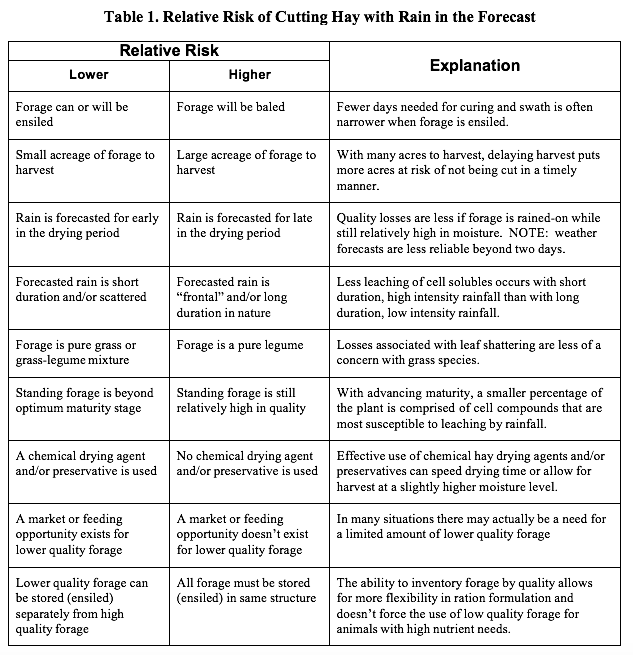How does rainfall reduce yield?
Three primary factors are involved: leaching, respiration, and leaf loss. Leaching is the movement of cell solubles out of the plant. Components of the plant that are very water-soluble are leached out of the forage and lost during a rain event. Unfortunately, most of these compounds are those highly digested by the animal. They include such things as readily available carbohydrates and soluble nitrogen, minerals, and lipids. About one-half of the dry matter leached by rain is soluble carbohydrate.
Excessive leaching of soluble carbohydrates by rainfall impacts its value to make good silage. Reduced soluble carbohydrates provide less substrate for bacteria involved in the fermentation process. In situations where soluble carbohydrates are in low concentrations, silage additives that provide fermentable substrate might provide some benefit to ensure proper fermentation.
Respiration, the breakdown of soluble carbohydrates by plant enzymes, will cause dry matter losses regardless of whether wilted forage is subjected to rain or not. Respiration losses occur while crop moisture levels are above about 30 percent. These losses are reported to be about 3 to 4 percent of the potential DM harvest. Each time cut forages are wetted by rain, respiration is prolonged or begins again in cases where the cured forage is already below 30 percent moisture. In either situation, additional dry matter is lost.
Researchers disagree about the amount of leaf loss that occurs in cut alfalfa as a direct result of rainfall. In a Wisconsin study, leaf loss ranged from 8 to over 20 percent of the initial forage dry matter where rainfall amounts were from 1 to 2.5 inches. In a Michigan study, direct leaf loss was much lower ranging from 0.5 to 4.2%. For both of these experiments, the cut forage was physically picked-up and lost leaves underneath the swath were weighed. In an Ontario study where forage was not hand-manipulated, rain-induced leaf loss was determined to be minimal (less than 0.5%).
Experience and common sense tell us that rain damaged alfalfa is more susceptible to leaf shatter after it dries. Rainfall often means additional raking or tedding to speed up drying; hence, more lost leaves.
How does rainfall intensity and forage moisture affect losses?
Research is conclusive on these two points. Given the same amount of total rainfall, a low intensity rain will result in more leaching of soluble compounds than a high intensity rain. In addition, as forage moisture declines, it is more prone to DM loss from rain. In Wisconsin rainfall studies, the maximum loss in DM (54% DM loss) was a treatment where 2.5 inches of rain fell on hay that was nearly cured.
Does rainfall affect forage quality?
Perhaps nothing is more frustrating than to see excellent quality alfalfa turn into cordwood with each passing rainstorm and subsequent raking. Most rainfall studies agree that wetting of field cured alfalfa has little impact on crude protein concentration. In fact, it is common to see relatively high protein values in comparison to fiber concentrations. However, because rain leaches soluble carbohydrates, structural fibers (acid and neutral detergent fibers) comprise a greater percent of the forage dry matter. Depending on numerous factors previously discussed, the digestibility of rained-on hay may decline from 6 to 40 percent.
My hay is ready to cut but there’s rain in the forecast. Do I cut or not?
This dilemma has faced forage producers for years. Because the impact of rainfall on loss of forage yield and quality varies with timing, amount, and duration, there is no easy answer. The range in economic loss from rainfall for a particular hay crop can range from minimal to over 100 percent, if the forage has to be chopped back onto the field. However, based on previous research studies and applied management practices, we can categorize factors that increase our risk of cutting hay when the weather forecast is somewhat less than perfect. These are presented in Table 1.
Finally, computer technology and the Internet now make it feasible for producers to have home access to up-to-date weather radar images. There are many excellent weather information web sites with both multiple radar image selections and updated forecasts. These help to take some of the “guess work” out of forage harvesting decisions.

Source:uwex.edu